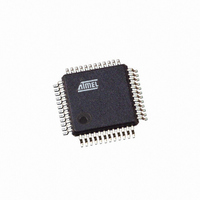ATMEGA406-1AAU Atmel, ATMEGA406-1AAU Datasheet - Page 27

ATMEGA406-1AAU
Manufacturer Part Number
ATMEGA406-1AAU
Description
IC AVR MCU 40K 1MHZ 48LQFP
Manufacturer
Atmel
Series
AVR® ATmegar
Specifications of ATMEGA406-1AAU
Core Processor
AVR
Core Size
8-Bit
Speed
1MHz
Connectivity
I²C
Peripherals
POR, WDT
Number Of I /o
18
Program Memory Size
40KB (20K x 16)
Program Memory Type
FLASH
Eeprom Size
512 x 8
Ram Size
2K x 8
Voltage - Supply (vcc/vdd)
4 V ~ 25 V
Data Converters
A/D 10x12b
Oscillator Type
Internal
Operating Temperature
-30°C ~ 85°C
Package / Case
48-LQFP
Processor Series
ATMEGA48x
Core
AVR8
Data Bus Width
8 bit
Data Ram Size
2 KB
Interface Type
2-Wire
Maximum Clock Frequency
1 MHz
Number Of Programmable I/os
18
Number Of Timers
2
Maximum Operating Temperature
+ 85 C
Mounting Style
SMD/SMT
3rd Party Development Tools
EWAVR, EWAVR-BL
Development Tools By Supplier
ATAVRDRAGON, ATSTK500, ATSTK600, ATAVRISP2, ATAVRONEKIT
Minimum Operating Temperature
- 30 C
Cpu Family
ATmega
Device Core
AVR
Device Core Size
8b
Frequency (max)
1MHz
Total Internal Ram Size
2KB
# I/os (max)
18
Number Of Timers - General Purpose
2
Operating Supply Voltage (typ)
5/9/12/15/18/24V
Operating Supply Voltage (max)
25V
Operating Supply Voltage (min)
4V
On-chip Adc
10-chx12-bit
Instruction Set Architecture
RISC
Operating Temp Range
-30C to 85C
Operating Temperature Classification
Commercial
Mounting
Surface Mount
Pin Count
48
Package Type
LQFP
Controller Family/series
AVR MEGA
No. Of I/o's
18
Eeprom Memory Size
512Byte
Ram Memory Size
2KB
Cpu Speed
1MHz
Rohs Compliant
Yes
For Use With
770-1007 - ISP 4PORT ATMEL AVR MCU SPI/JTAG770-1005 - ISP 4PORT FOR ATMEL AVR MCU JTAG770-1004 - ISP 4PORT FOR ATMEL AVR MCU SPI
Lead Free Status / RoHS Status
Lead free / RoHS Compliant
Available stocks
Company
Part Number
Manufacturer
Quantity
Price
Part Number:
ATMEGA406-1AAU
Manufacturer:
AT
Quantity:
20 000
7.4
7.5
7.6
7.7
2548E–AVR–07/06
32 kHz Crystal Oscillator
Slow RC Oscillator
Ultra Low Power RC Oscillator
CPU, I/O, Flash, and Voltage ADC Clock
XTAL1 and XTAL2 are input and output, respectively, of an inverting amplifier which can be con-
figured for use as an On-chip Oscillator, as shown in
use with a 32.768 kHz watch crystal.
C1 and C2 should always be equal. The optimal value of the capacitors depends on the crystal
or resonator in use, the amount of stray capacitance, and the electromagnetic noise of the envi-
ronment. For information on how to choose capacitors and other details on Oscillator operation,
refer to the 32 kHz Crystal Oscillator application note.
Figure 7-2.
The Slow RC Oscillator provides a fixed 131 kHz clock. This clock source can be used as a
backup clock source in case of 32 kHz Crystal Oscillator failure. It can also be used as the only
Run-Time clock source in systems where the resulting clock accuracy is acceptable. To provide
good accuracy when used as a Run-Time clock source, the slow RC Oscillator has a calibration
byte stored in the signature address space. See the section
order to get the actual timeout periods, the application software must use this calibration byte to
scale the WUT time-outs found in
The Ultra Low Power RC Oscillator (ULP Oscillator) provides a clock of 128 kHz. It operates at
very low power consumption, at the expense of frequency accuracy.
The clock source for the CPU, I/O, Flash, and Voltage ADC is the calibrated Fast RC Oscillator.
Note that the Calibrated Fast RC Oscillator will provide a 4 MHz clock to the TWI module and a
1 MHz clock to all other modules.
When the CPU wakes up from Power-down or Power-save, the CPU clock source is used to
time the start-up, ensuring a stable clock before instruction execution starts. When the CPU
starts from reset, there is an additional delay allowing the voltage regulator to reach a stable
level before commencing normal operation. The Ultra Low Power RC Oscillator is used for tim-
ing this real-time part of the start-up time. Start-up times are determined by the SUT Fuses as
32 kHz Crystal Oscillator Connections
Table 10-1 on page
C2
C1
Figure
50.
XTAL2
XTAL1
GND
”Calibration Bytes” on page
7-2. This Oscillator is optimized for
ATmega406
198. In
27





















